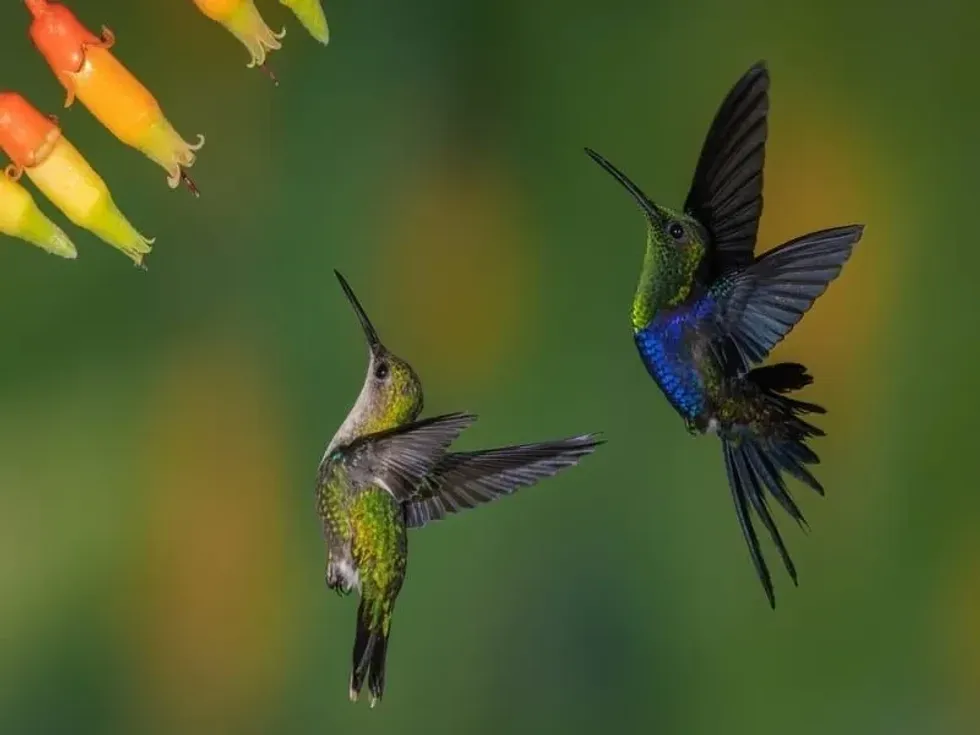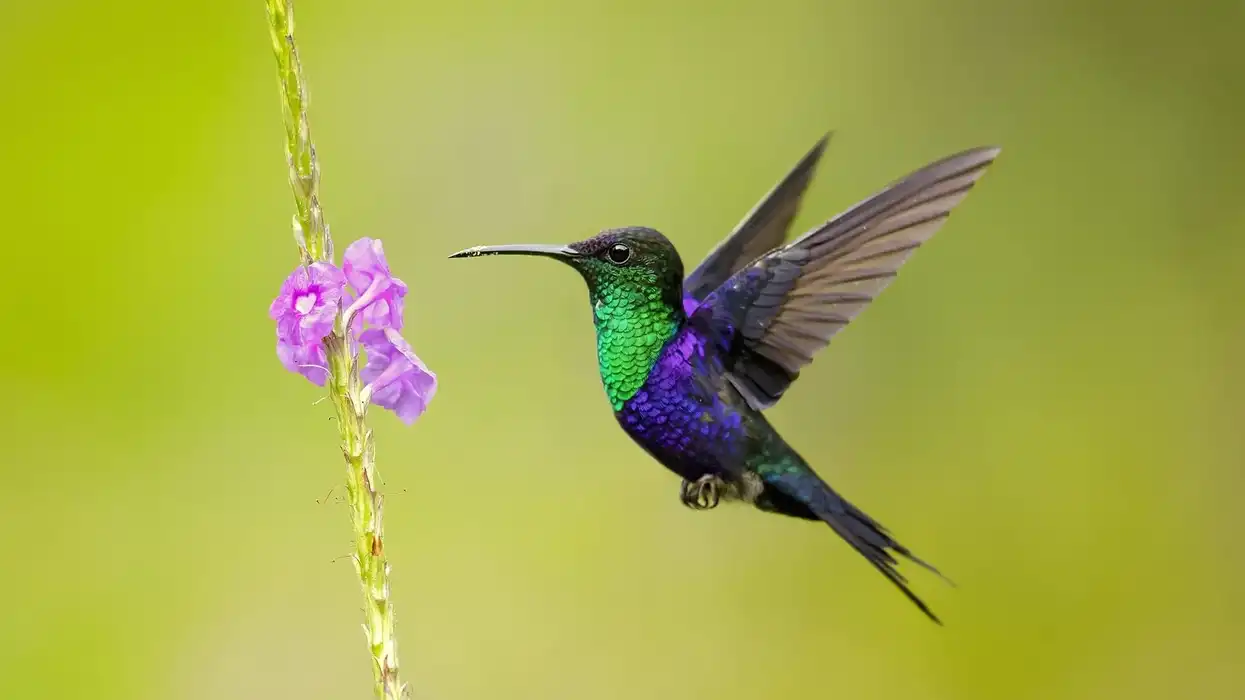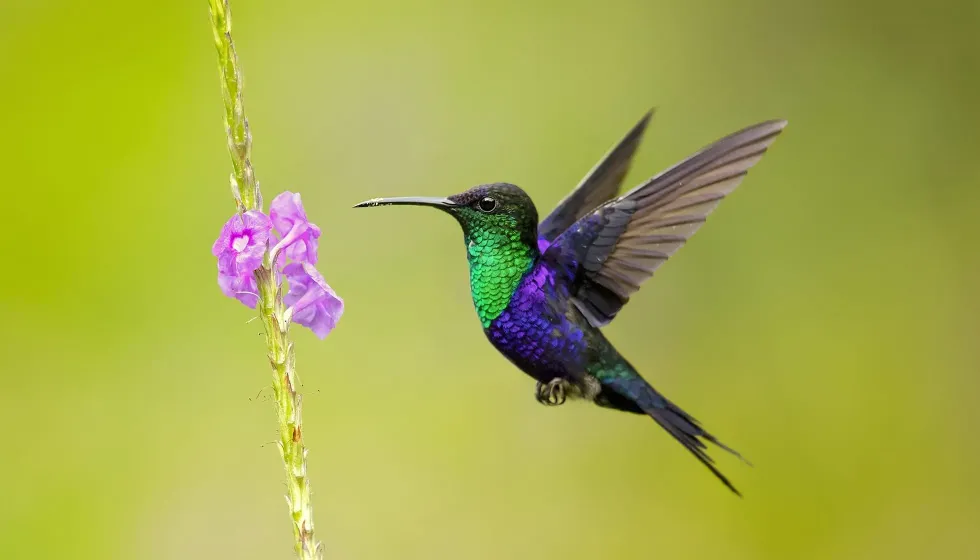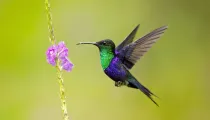Fun Crowned Woodynymph Facts For Kids

Crowned woodnymph is a species of bird found in Belize, Guatemala, Colombia, and Peru. The bird is a species of the hummingbird family Trochilidae.
The bird species fall under the genus Thalurania and was formally described in 1848 by John Gould. The species crowned woodnymph (Thalurania colombica) is also known as violet crowned woodnymph, purple-crowned woodnymph, blue-crowned woodnymph, citado woodnymph, and Colombian woodnymph.
The species is closely related to the green crowned woodnymph (Thalurania fannyi) and Mexican woodnymph (Thalurania ridgwayi). All these names and species were earlier considered subspecies of crowned woodnymph (Thalurania colombica), however, all of them are now termed as separate species.
However, there is some research stating that green crowned woodnymph, emerald-bellied woodnymphm, and violet crowned woodnymph are the same species and are lumped together as the crowned woodnymph. Emerald-bellied woodnymph is considered a subspecies of green crowned woodnymph.
These brightly-colored birds are quite popular in the region, however, the female is duller than the male. We shall know more about these birds in the next part of the article.
Hummingbirds have always been a sight to watch and these woodnymph birds are no different. The violet-crowned woodnymph and green-crowned woodnymph have recently been re-lumped into a single species.
For more relatable content, check out these cryptic treehunter facts and chicken fun facts.
Crowned Woodnymph Interesting Facts
What type of animal is a crowned woodnymph?
Crowned woodnymph is a species of hummingbird in the family of Trochilidae.
What class of animal does a crowned woodnymph belong to?
Violet crowned woodnymph (Thalurania colombica) falls under the class of Aves in the kingdom of Animalia.
How many crowned woodnymphs are there in the world?
The population of the violet crowned woodnymph is not known. However, these birds are quite well distributed and found in an area of 2,480,000 sq km in their preferred habitat. The population trend is currently decreasing.
Where does a crowned woodnymph live?
All species and subspecies related to the violet crowned woodnymph (Thalurania colombica) are found in Colombia, Belize, Guatemala, and northern Peru. The birds can be found in the Caribbean slopes of Guatemala and southern Belize. They are common in northern Colombia and Venezuela.
Some scattered populations can also be seen in Honduras, Nicaragua, and Panama. There are also reports of sighting these birds in Costa Rica of Central America, but cannot be corroborated.
What is a crowned woodnymph's habitat?
The crowned woodnymph habitat consists of subtropical and tropical moist lowland forest, subtropical and tropical moist montane forest. The birds are found in wet lowlands and foothills of areas of elevation up to 8200 ft (2499.3 m). The woodnymphs even move further up outside the breeding season. They are also found in areas of tall second-growth and semi-open areas.
All the subspecies are found in the same habitat.
Who do crowned woodnymphs live with?
These hummingbirds are usually solitary and do not move in pairs or flocks. They only make pairs for the season and separate right after. Female and male species have different territories where the female territories are much bigger and better. Female is known to defend the territories better and the areas have more nectar content.
How long does a crowned woodnymph live?
The lifespan of the bird is not known. Generally, hummingbirds are known to live for three to five years. Some species have also been known to live for a longer period of 10 years.
How do they reproduce?
The female of the violet crowned woodnymph is fully responsible for nest building and raising the young. Males only take part in the mating process with the female. Males are known to show courting behavior by flying in a U-shaped pattern.
After copulation, males leave immediately. A single male can mate with several of the female species at one time. Sometimes, females also do the same.
Female birds make a cup-shaped nest with plant fibers and green moss on the outside. The nest is placed in a protected location in a shrub, bush, or tree in a low, thin horizontal branch.
A clutch of two white eggs is laid by the female and the bird incubates it alone without any involvement from the male. The incubation period is 15-19 days. After the eggs hatch, the young are born blind and immobile. Females alone feed and protect the young for around 12 days.
Food is mostly partially-digested insects that are pushed down the throat of the young by the mother's long bill. Chicks are too young to take in nectar as food. Chicks leave the nest after approximately 26 days.
The males only defend their territories and the flowers they feed on.
What is their conservation status?
The conservation status of the violet crowned woodnymph (Thalurania colombica) is categorized as Least Concern by the IUCN Red List. There is no immediate danger to the population of the species, however, it is known to be decreasing due to habitat degradation and predator attacks.
Crowned Woodnymph Fun Facts
What do crowned woodnymphs look like?
Violet crowned woodnymph (Thalurania colombica) is a medium-sized hummingbird. Males of the species are known to have a violet/blue crown on the head and violet coloration on the shoulders, upper back, and belly. A shiny green throat and breast can be seen too with a green lower back. The bird also has a blue-black tail that is forked.
Females are quite different with bright green plumage. A bright green coloration can be seen in the upper body and duller green in the lower part. The throat and breast are colored gray. The tail is rounded with green coloration near the body. The lower half is blue-black colored with white corners.
The female crowned woodnymph size is slightly smaller than the male of the birds with the female having a length of 3.3-3.5 in (8.3-8.9 cm). The male birds are slightly bigger at about 4 in (10.1 cm).
Juveniles of the bird do not have the violet coloration as male adults. They are bronze-colored in the lower body. The face, rump, and nape feathers have buff fringes, as seen in female chicks.
Males of the green-crowned woodnymph and the violet-crowned woodnymph (Thalurania colombica) are similar to the males of the violet-bellied hummingbird. However, the green-crowned woodnymph is larger in size and has a forked tail, with a decurved and black bill.

How cute are they?
The bright violet coloration of the male birds as well as the beautiful green in the females make the crowned woodnymphs one of the most spectacular hummingbirds to watch. Also, the iridescence that can be seen on males looks beautiful.
How do they communicate?
Violet crowned woodnymph makes a call with the sound of 'kip'. The sound is high-pitched and fast. However, most of the time, the bird stays quiet.
How big is a crowned woodnymph?
The violet-crowned woodnymph (Thalurania columbrica) is a tiny species of hummingbird that is 4.01 in (10.2 cm) long.
Bee hummingbird, the smallest bird in the world has a range of length of 2.1-2.4 in (5.3-6.1 cm).
How fast can a crowned woodnymph fly?
The flight speed of the bird is not known. Hummingbirds generally are pretty quick with Anna's Hummingbird clocking a speed of 60.8 mph (97.8 kph).
How much does a crowned woodnymph weigh?
The weight of the violet crowned woodnymph (Thalurania colombica) has a range of 0.007-0.01 lb (3.1-4.5 g).
What are the male and female names of the species?
Males and females of the species are not given different names. They are known by various different names all over the world and by the scientific name given to the birds.
What would you call a baby crowned woodnymph?
Babies of crowned woodnymphs are called chicks or young. They are sometimes called juveniles.
What do they eat?
The violet crowned woodnymph (Thalurania colombica) primarily feeds on the nectar of flowers of trees, herbs, shrubs, and epiphytes. The feeding habit is the same as any other hummingbird in the world.
The birds have an attraction for brightly colored, scented small flowers. These flowers need to have a high sugar content and the birds are known to aggressively find and protect the areas with these flowers.
These hummingbirds feed by hanging on the flowers or by hovering. They use their long, extendible, straw-like tongues to suck the nectar from the flowers.
When flowers are not available in the winter season, the birds drink the saps from the holes in the trees made by sapsuckers. They can also be found in hummingbird feeders sipping on sugar water. Insects provide important protein during the breeding season for the young. Females are known to catch 2000 insects in a day.
Hummingbirds, generally, are known to eat insects such as ants, wasps, mites, mosquitos, weevils, spiders, beetles. Some species of hummingbirds are also known to feed on caterpillars and aphids right from leaves on trees.
Are they dangerous?
They are not at all dangerous.
Would they make a good pet?
Violet crowned woodnymph (Thalurania colombica) is not considered a pet because they need a proper habitat to thrive. This can only be available in the wild.
Did you know...
The violet crowned woodnymph types of subspecies include Thalurania colombica colombica found in northern Colombia and Venezuela, Thalurania colombica townsendi found in Guatemala and Honduras, Thalurania colombica venusta found in Nicaragua and Panama, and Thalurania colombica rostrifera found in Venezuela and Táchira.
The green-crowned woodnymph also has few subspecies under them such as Thalurania fannyi hypochlora found in Peru and Ecuador, Thalurania fannyi subtropicalis of Colombia, and Andes, and Thalurania fannyi verticeps of the Andes in Colombia and Ecuador.
The green and the violet woodnymphs have been called the same species just recently.
These birds are known to suck nectar from scented, red-colored, and tubular-shaped flowers with high sugar content.
Naming the crowned woodnymph
South American violet crowned woodnymph (Thalurania colombica) is known by many different names such as purple-crowned woodnymph, blue-crowned woodnymph, citado woodnymph, green-crowned woodnymph, and Colombian woodnymph. There are some doubts on the classification of some of the species and subspecies of birds, but they are named crowned woodnymph because of their violet crowns on the head of the male.
The female usually lacks the crown and are bright green in color.
What role does the crowned woodnymph hummingbird play in the ecosystem?
These birds help the ecosystem by being pollinators. They play an important role in pollination as while feeding, the bird touches the male parts of the flower and gets the pollen attached all over its body. When the hummingbirds move around, they help in depositing these pollens in different parts of the forests.
Here at Kidadl, we have carefully created lots of interesting family-friendly animal facts for everyone to discover! For more relatable content, check out these frigate facts and tawny owl facts for kids.
You can even occupy yourself at home by coloring in one of our free printable bird coloring pages.
We Want Your Photos!
More for You
See All
Bachelor of Arts specializing in English

Ritwik BhuyanBachelor of Arts specializing in English
A skilled content writer, Ritwik holds a Bachelor's degree in English from Delhi University. He has refined his writing abilities through his past experience at PenVelope and his current role at Kidadl. In addition to his proficiency in writing, Ritwik has pursued his passion for flying by achieving CPL training and becoming a licensed commercial pilot. This diverse skill set highlights his commitment to exploring multiple fields. Ritwik's experience in the aviation industry has provided him with a unique perspective and attention to detail, which he brings to his writing.
Postgraduate Diploma in Management

Sakshi RaturiPostgraduate Diploma in Management
Sakshi has experience in marketing strategy, social media planning, and recruiting industry experts for capstone projects, she has displayed a commitment to enhancing their skills and knowledge. She has won multiple awards, including a Certificate of Appreciation for Creative Writing and a Certificate of Merit for Immaculate Turut, and is always seeking new opportunities to grow and develop.
Disclaimer
1) Kidadl is independent and to make our service free to you the reader we are supported by advertising. We hope you love our recommendations for products and services! What we suggest is selected independently by the Kidadl team. If you purchase using the Buy Now button we may earn a small commission. This does not influence our choices. Prices are correct and items are available at the time the article was published but we cannot guarantee that on the time of reading. Please note that Kidadl is a participant in the Amazon Services LLC Associates Program, an affiliate advertising program designed to provide a means for sites to earn advertising fees by advertising and linking to Amazon. We also link to other websites, but are not responsible for their content.
2) At Kidadl, we strive to recommend the very best activities and events. We will always aim to give you accurate information at the date of publication - however, information does change, so it’s important you do your own research, double-check and make the decision that is right for your family. We recognise that not all activities and ideas are appropriate for all children and families or in all circumstances. Our recommended activities are based on age but these are a guide. We recommend that these ideas are used as inspiration, that ideas are undertaken with appropriate adult supervision, and that each adult uses their own discretion and knowledge of their children to consider the safety and suitability. Kidadl cannot accept liability for the execution of these ideas, and parental supervision is advised at all times, as safety is paramount. Anyone using the information provided by Kidadl does so at their own risk and we can not accept liability if things go wrong.
3) Because we are an educational resource, we have quotes and facts about a range of historical and modern figures. We do not endorse the actions of or rhetoric of all the people included in these collections, but we think they are important for growing minds to learn about under the guidance of parents or guardians.







